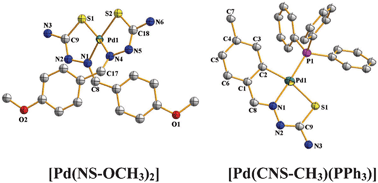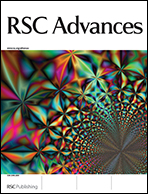Reaction of a 1 : 1 mixture of 4-R-benzaldehyde thiosemicarbazone (R = OCH3, CH3, H, Cl and NO2) and 2-picolinic acid with an equivalent quantity of Na2[PdCl4] in ethanolic medium, under relatively mild reflux, affords a group of complexes of type [Pd(NS–R)2] as the major product and another family of complexes of type [{Pd(CNS–R)}n] as the minor product (where NS–R and CNS–R denote the N,S- and C,N,S-coordinated thiosemicarbazone, respectively). The [{Pd(CNS–R)}n] complexes are conveniently obtained in good yields from similar reactions carried out under prolonged reflux. The sulfur-bridge in the [{Pd(CNS–R)}n] complexes undergoes facile cleavage upon their reaction with triphenylphosphine to yield complexes of type [Pd(CNS–R)(PPh3)]. Crystal structures of [Pd(NS–OCH3)2], [Pd(NS–CH3)2], [Pd(NS–Cl)2], [Pd(CNS–CH3)(PPh3)], [Pd(CNS–H)(PPh3)] and [Pd(CNS–Cl)(PPh3)] have been determined. In the [Pd(NS–R)2] complexes the thiosemicarbazones are coordinated to the metal center, via dissociation of the acidic proton, as monoanionic bidentate N,S-donors forming five-membered chelate rings, while in the [Pd(CNS–R)(PPh3)] complexes they are coordinated to palladium, via dissociation of the acidic proton and activation of an ortho C–H bond, as dianionic tridentate C,N,S-donors forming two adjacent five-membered chelate rings. The [Pd(NS–R)2] and [Pd(CNS–R)(PPh3)] complexes show characteristic 1H NMR signals, and in dichloromethane solution they all display intense absorptions in the visible and ultraviolet regions. The [Pd(NS–R)2] and [Pd(CNS–R)(PPh3)] complexes have shown notable efficiency in catalyzing C–C and C–N coupling reactions.


 Please wait while we load your content...
Please wait while we load your content...